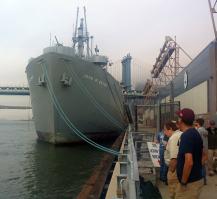 Last Sunday, I had the opportunity to spend a little time in the engine room of the Liberty ship, SS John W. Brown. The ship, normally based in Baltimore, was visiting New York and offered a full day “Living History Cruise.”
Last Sunday, I had the opportunity to spend a little time in the engine room of the Liberty ship, SS John W. Brown. The ship, normally based in Baltimore, was visiting New York and offered a full day “Living History Cruise.”
One of the most interesting aspects of this fascinating ship is the 2,500 horsepower triple expansion reciprocating steam engine. Liberty ships were one of the first mass-produced ships. Built during World II, the goal was to build cargo ships faster than German submarines could sink them. The US built 2,710 Liberty ships in 18 shipyards around the United States, by far the largest series of ships to be built of the same design in history. Each ship was built in an average of 44 days. The problem was that steam turbine power plants, particularly the reduction gears, could not be built fast enough to keep up with Liberty ship construction. The triple expansion steam engines installed in the ships were obsolete when the Liberty ships were built, but they could be built quickly, were reliable, and relatively easy to maintain. The engine on the John Brown is a beauty to behold, a blend of machinery and living sculpture.
Liberty Ship S.S. John W. Brown, Underway in the Engine Room

Could it be that obsolete engines were installed so that the post war shipbuilding industry would not be harmed by a great oversupply of vessels, as happened after WW 1? I know there was a shortage of the machines that cut reduction gear teeth, but shortages were overcome in many other areas.
Rick, thank you for the excellent video. Having spent, cumulatively, 2 years at sea over a 4 year period on 3 different aircraft carriers, I never got to see a working engine room. They wouldn’t let an airedale down there, which is a good thing!
The unique filming angles and subjects allowed me into a world I’ve never experienced before. And to see a triple expansion engine at work is genuinely amazing.
You’ve done this potential maritime historian a great service.
BZ to you, sir.
I probably shouldn’t have used the word obsolete. The triple expansion engines were less efficient than steam turbines, but were highly reliable and far easier to build. The war ships which needed higher speeds got the steam turbines while cargo ships operating in 11 knot convoys got the triple expansion engines.The other approach to not having enough reduction gear production capacity was the turbine-electric plant on the T2 tankers.
Too bad the music covers the sound of the engine, I stopped watching it.
Great Video,
The 1997 Titanic Movie used Jeremiah O’Brien running Triple Expansion Steam engine as a prop.
-There were Fourteen companies building Liberty Ship engines. They’re similar to water works triple expansion pumping engines, without flywheels.
https://www.asme.org/getmedia/f558ea74-61d6-4650-92f3-d980c237c373/98-SS-Jeremiah-O-Brien-1943.aspx
Cant hear anything why does everyone have to mask the original sounds same with old aircraft and very annoying.
The music is pulled down so the sound of the engine is still there. For those who really want the sound of the engine alone, here it is.
https://youtu.be/MQs6iyUdmUo
Thank you for posting the video without music. This one is much more interesting!
Pingback: Maritime Monday for October 3rd, 2016 – gCaptain
Pingback: New York History Around The Web This Week | The New York History Blog
I shipped aboard Zebulon B.Vance, Liberty Ship converted to a troop transport, as a military dependent in Sept. 1948. Bremerhaven to NYC, 16 1/2 days! But we had dining room-waiter service and only four to a cabin.
Stanley Sandler